QUESTIONS
1 Which statement is false about patients with homocystinuria?
A) Affected individuals have osteoporosis and progressive renal dysfunction.
B) Patients are abnormal from birth, with seizures and mental retardation.
C) Ectopia lentis may occur in over 30%.
D) Patients may benefit from a diet low in methionine and high in cysteine.
2 Which statement about galactosemia is true?
A) Disease effects are limited to the eye.
B) Cataracts are inevitably progressive.
C) It can result from a defect in galactokinase or galactose-1-P uridyl transferase.
D) It can lead to an accumulation of galactose in the lens, forming a snowflake cataract.
3 All of the following are characteristics of patients with Lowe syndrome except:
A) autosomal dominant inheritance
B) renal tubular acidosis
C) bilateral congenital cataracts
D) infantile glaucoma
4 True statements concerning the conjunctivitis in the neonate pictured in Figure 5-1 include each of the following except:
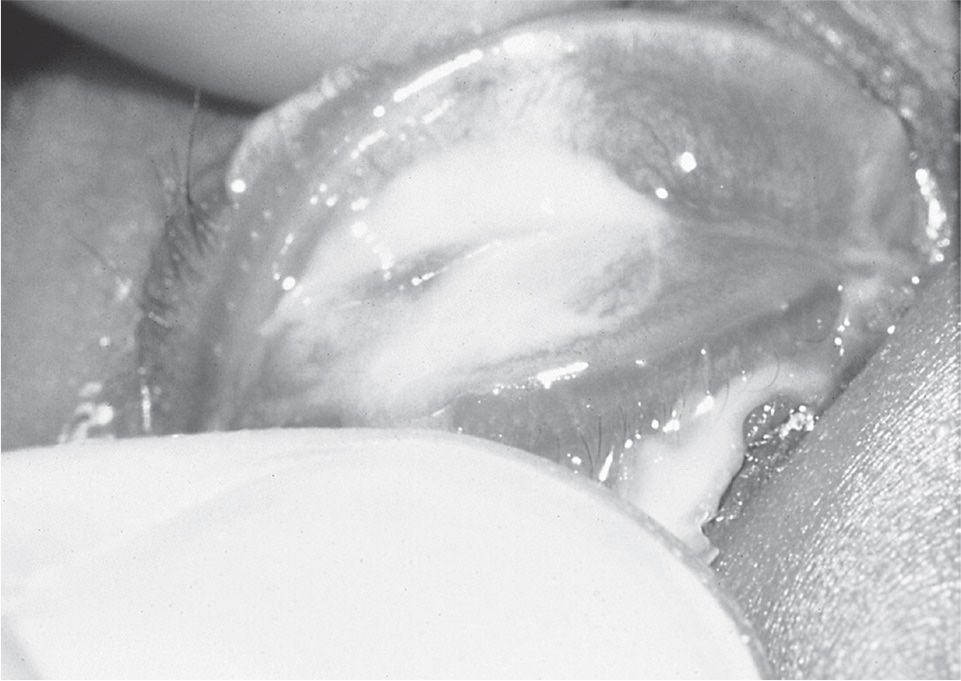
A) Definitive diagnosis can be made by seeing intracytoplasmic inclusion bodies on Giemsa stain.
B) Herpes simplex is not an important cause in infants under 4 weeks of age.
C) Differential diagnosis includes both viral and bacterial diseases.
D) Initial workup should include particular attention to the corneal epithelium.
5 A newborn infant presents with the condition shown in Figure 5-2. Which one of the following statements is least accurate with regard to the condition in Figure 5-2?
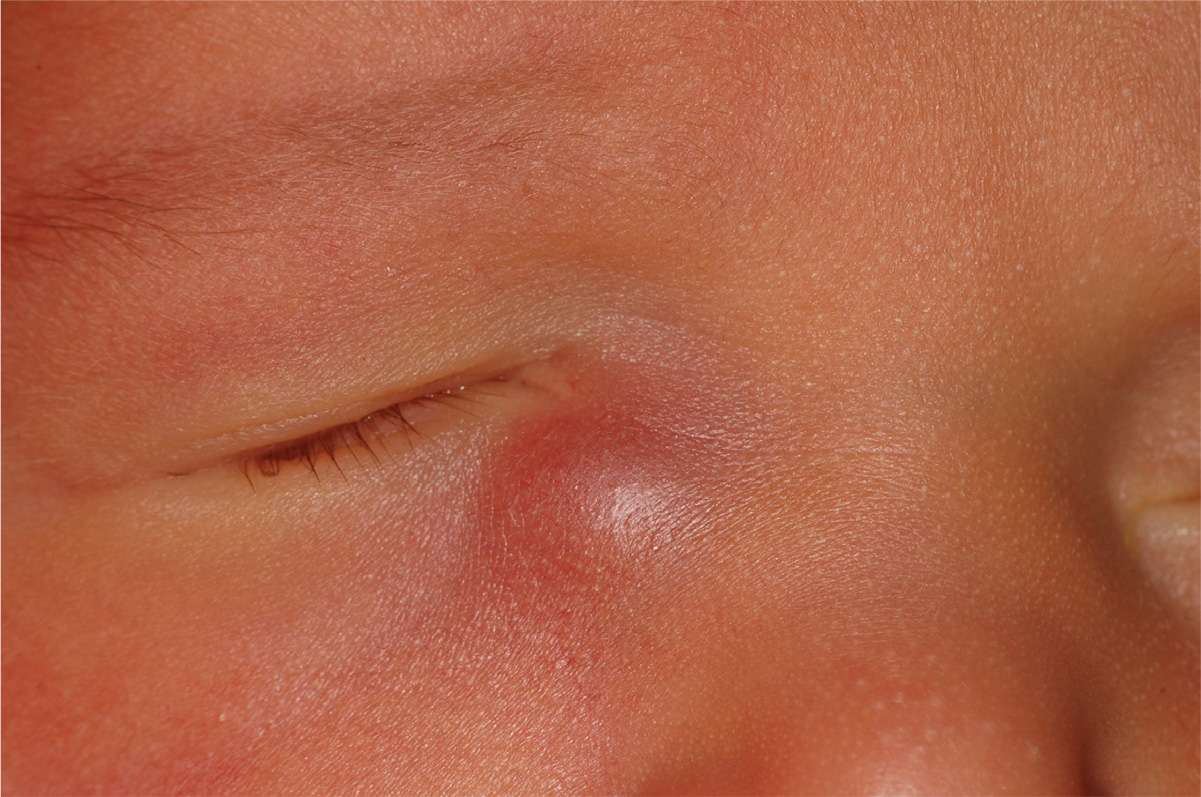
A) Differential diagnosis includes hemangioma, encephalocele, and dermoid cyst.
B) Patients present with significant retrograde discharge into the eye.
C) Swelling is caused by trapped amniotic fluid.
D) This condition can be associated with respiratory compromise.
6 The left eye of a 2-year-old child is shown in Figure 5-3. The punctum is cannulated, and fluorescein solution is irrigated (Fig. 5-4). Which one of the following statements is false?
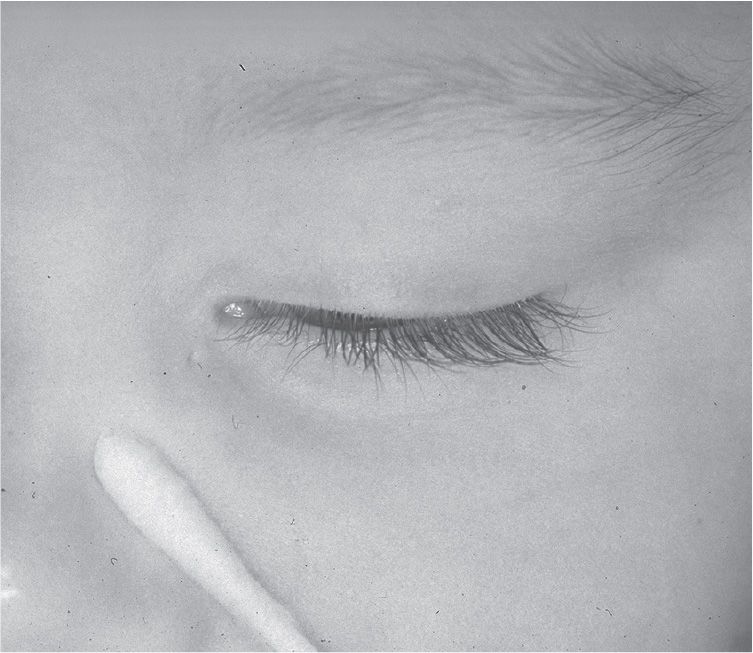

A) This condition is associated with tear reflux and nasolacrimal duct obstruction.
B) The anomaly involves an abnormality of neural ectoderm.
C) If this condition is infected, topical antibiotics are usually sufficient to temporize the condition.
D) These tracts are lined with epithelium.
7 Which one of the following statements regarding megalocornea is false?
A) This condition is defined as a clear normal-appearing cornea with a diameter measuring greater than 13 mm.
B) This condition is often associated with anterior megalophthalmos, an autosomal dominant disorder.
C) The simple form of megalocornea is usually seen as a bilateral condition.
D) Tearing and IOP are important factors in the workup.
8 Which one of the following statements concerning Figure 5-5 is false?
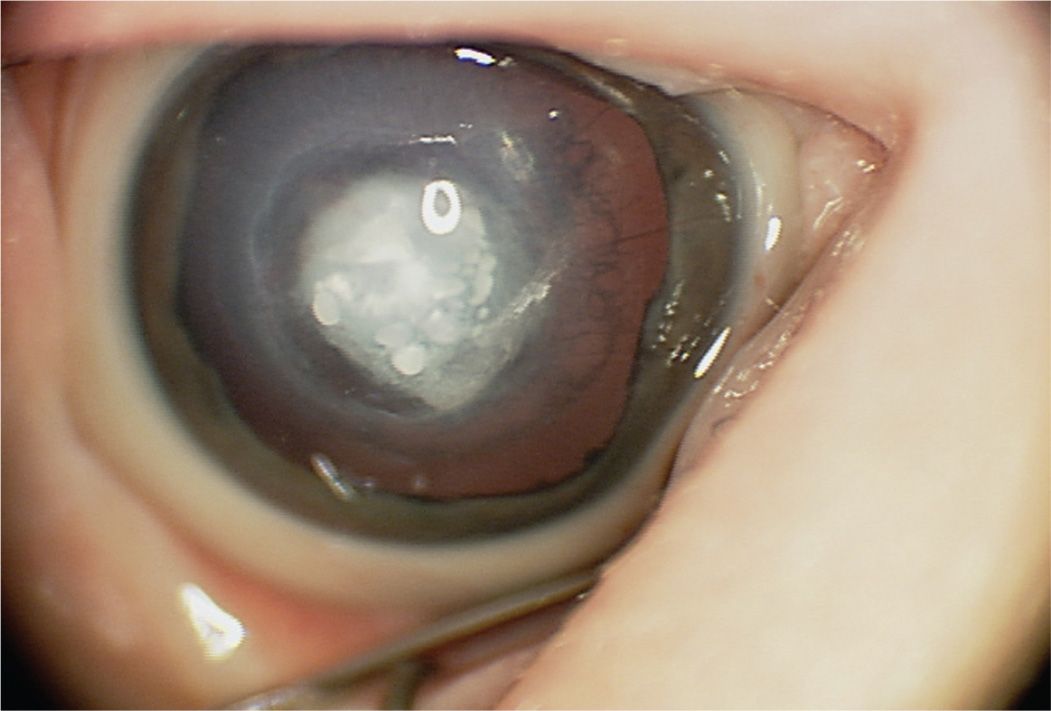
A) This developmental anomaly can demonstrate both lens and iris adhesions to the corneal endothelium.
B) The condition has progressive corneal opacification.
C) The peripheral cornea is unaffected.
D) This condition results from a developmental problem with neural crest cells.
9 A 3-year-old girl presents with the lesion shown in Figure 5-6. All of the following statements are true except:
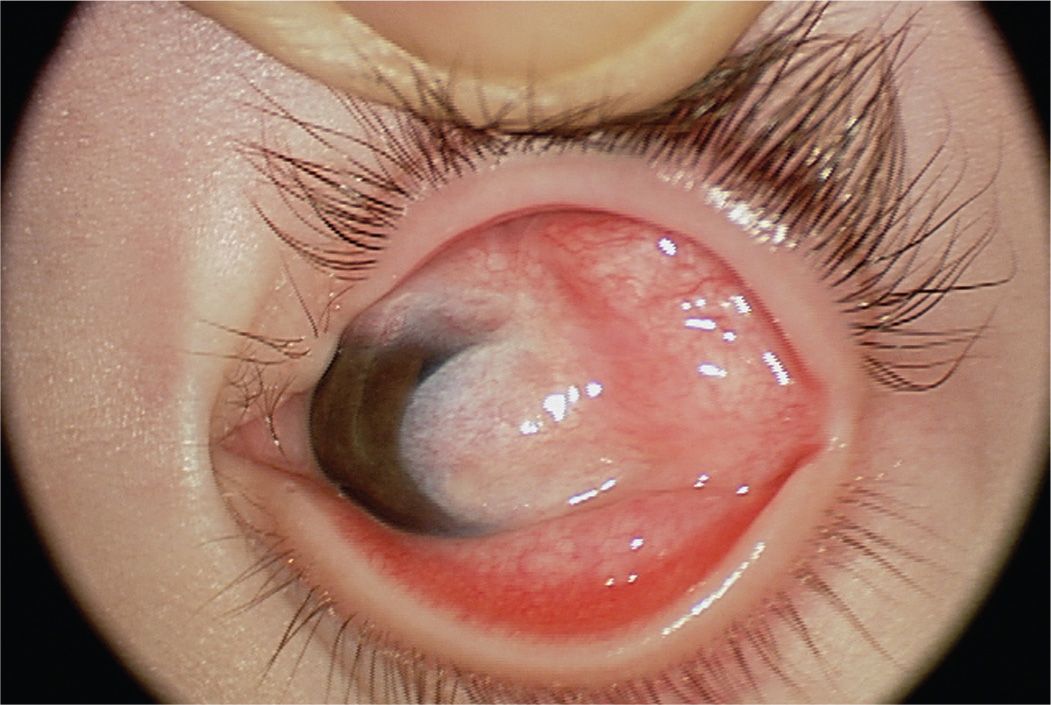
A) This lesion is anterior to Bowman membrane and can be scraped off without concern of stromal involvement.
B) Associated findings include preauricular skin tags, upper eyelid coloboma, and vertebral anomalies.
C) Often, there is an associated arc of lipid in the cornea in advance of the lesion.
D) These lesions may have hair follicles or sweat glands in them.
10 All of the following are true regarding the condition shown in Figure 5-7, except:

A) 50% of patients develop glaucoma.
B) Patients with this condition are found to have mutations in PITX2 and FOXC1.
C) Systemic abnormalities include redundant periumbilical skin, hypospadias, and microdontia.
D) Autosomal recessive inheritance is most common.
11 All of the following are causes of heterochromic irides except:
A) Horner syndrome
B) albinism
C) juvenile xanthogranuloma (JXG)
D) Waardenburg–Klein syndrome
12 Which one of the following ocular or systemic condition is not associated with ectopia lentis (Fig. 5-8)?
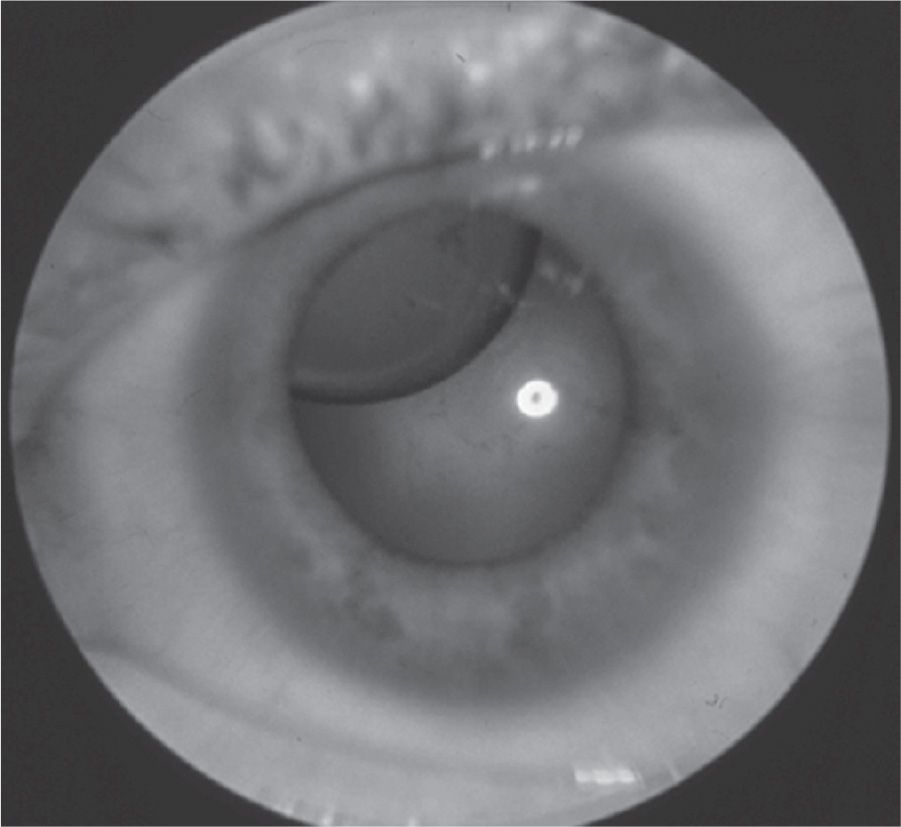
A) Homocystinuria
B) Aniridia
C) Microcornea
D) Weill–Marchesani
13 A 1-month-old infant presents with bilateral nuclear cataracts (Fig. 5-9). What is the most common identifiable cause for the cataracts?
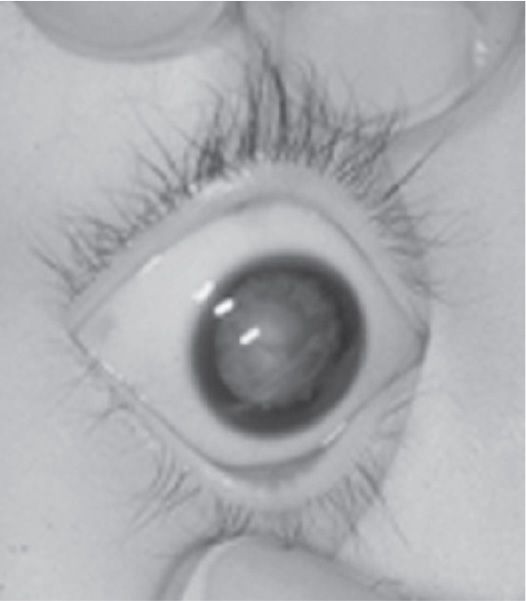
A) Hereditary autosomal dominant
B) Persistent hyperplastic primary vitreous (PHPV)
C) Galactosemia
D) Intrauterine infection
14 What is the optimum time to operate on a patient with bilateral dense congenital cataracts?
A) As soon as possible, even within the first few weeks of life
B) Between 2 months and 6 months of age
C) Between 6 months and 1 year of age
D) Between 1 and 2 years of age
15 Which one of the following is the preferred treatment for congenital cataracts in the 1-month-old infant with compliant parents?
A) Lensectomy, anterior vitrectomy, and fitting of contact lens
B) Intracapsular cataract extraction with contact lens fitting
C) Aspiration of lens and implantation of posterior chamber IOL
D) Lensectomy, anterior vitrectomy, and fitting with aphakic glasses
16 Each of the following statements regarding the disease depicted in Figure 5-10 is true except:
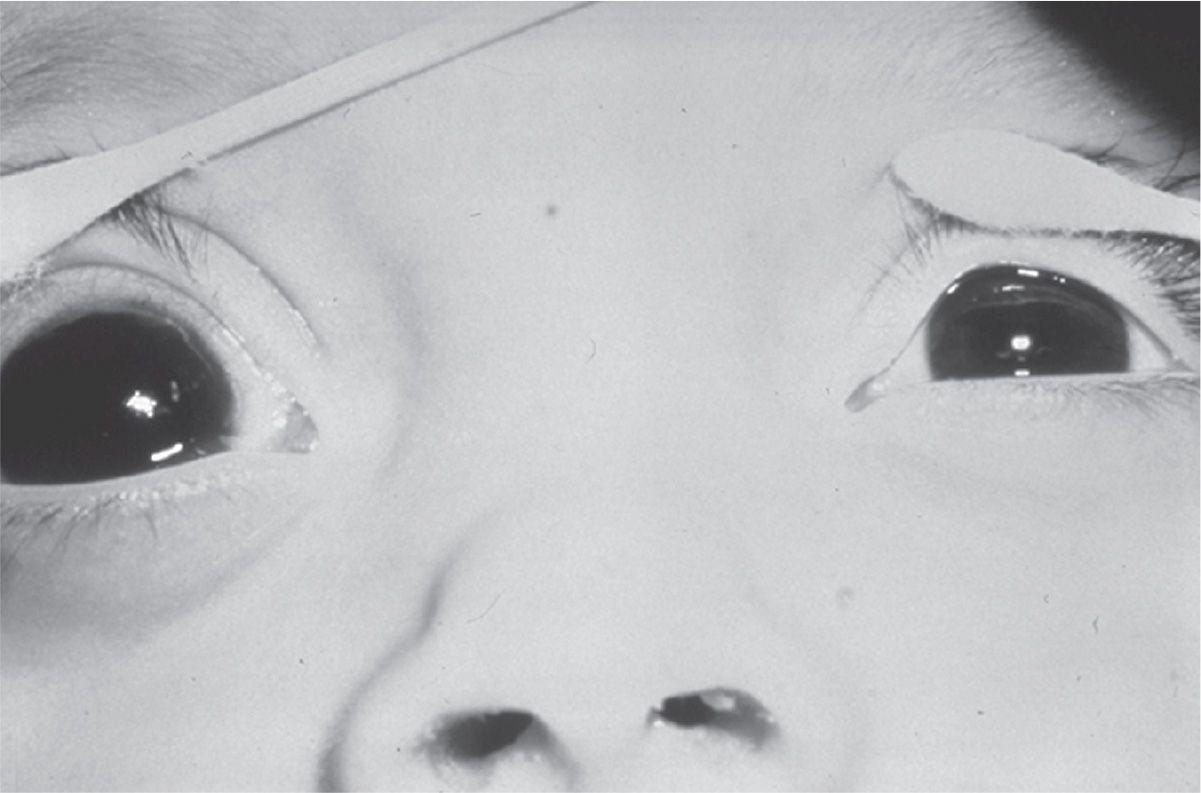
A) Photophobia and tearing may be the only presenting signs.
B) Although surgical therapy is usually indicated, medical therapy is often used initially.
C) Gonioscopy has clearly identifiable landmarks facilitating goniotomy as a first-line therapy.
D) Horizontally oriented breaks in Descemet membrane may be found in the buphthalmic eye.
QUESTIONS 17 and 18 A 3-year-old child with newly diagnosed juvenile idiopathic arthritis (JIA) is referred for an initial ophthalmic consultation.
17 The parents are anxious to know the risk of developing uveitis. Which historical information is least helpful in answering their question?
A) Gender of patient
B) Antinuclear antibody (ANA) positivity
C) Number of joints involved
D) Ocular complaints
18 The above patient is ANA-positive and has bilateral knee involvement. How often does she need to undergo ophthalmic evaluation?
A) Every 6 weeks
B) Every 3 months
C) Every 6 months
D) Annually
19 A 3-month-old infant presents with nystagmus and photophobia. Anterior segment and fundus photos are shown in Figures 5-11 and 5-12. All of the following statements regarding this condition are true except:

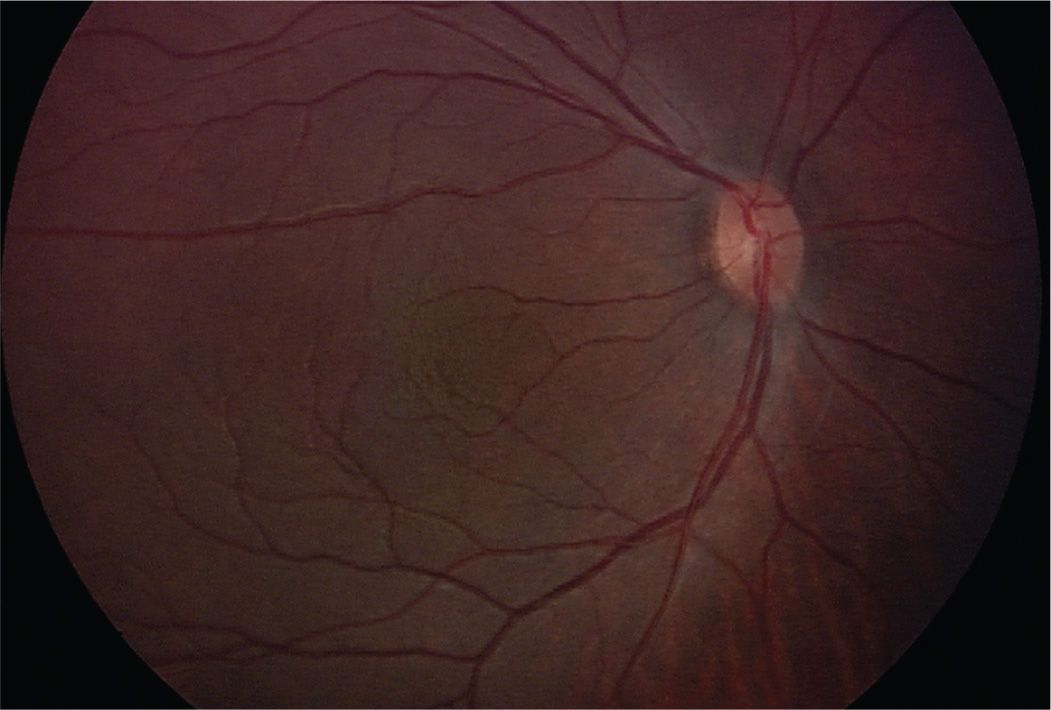
A) Both familial and sporadic cases have been reported.
B) Visual acuity is typically 20/100 or worse.
C) It is associated with corneal pannus.
D) The familial form of this condition is associated with nephroblastoma.
QUESTIONS 20 and 21 An infant girl is born 4 weeks prematurely and manifests jaundice, an intractable rash, persistent rhinitis, pneumonia, anemia, generalized lymphadenopathy, and bony abnormalities on radiograph.
20 Which one of the following historical features is the most important when questioning the mother regarding the history of the pregnancy?
A) Diet
B) Alcohol or drug use
C) Exposure to environmental toxins
D) Sexual history
21 Which one of the following findings would most likely be present on ophthalmic examination of this newborn child?
A) Interstitial keratitis
B) Segmental pigmentation of the retinal periphery and chorioretinitis
C) Scleritis
D) Anterior uveitis
22 All of the following would be considered in the differential diagnosis of vitreous hemorrhage in an 8-year-old child except:
A) trauma
B) juvenile X-linked retinoschisis
C) pars planitis
D) melanocytoma
23 An 8-year-old boy presents with 20/60 vision and exhibits the macular finding shown in Figure 5-13. Which one of the following is not true of this disorder?
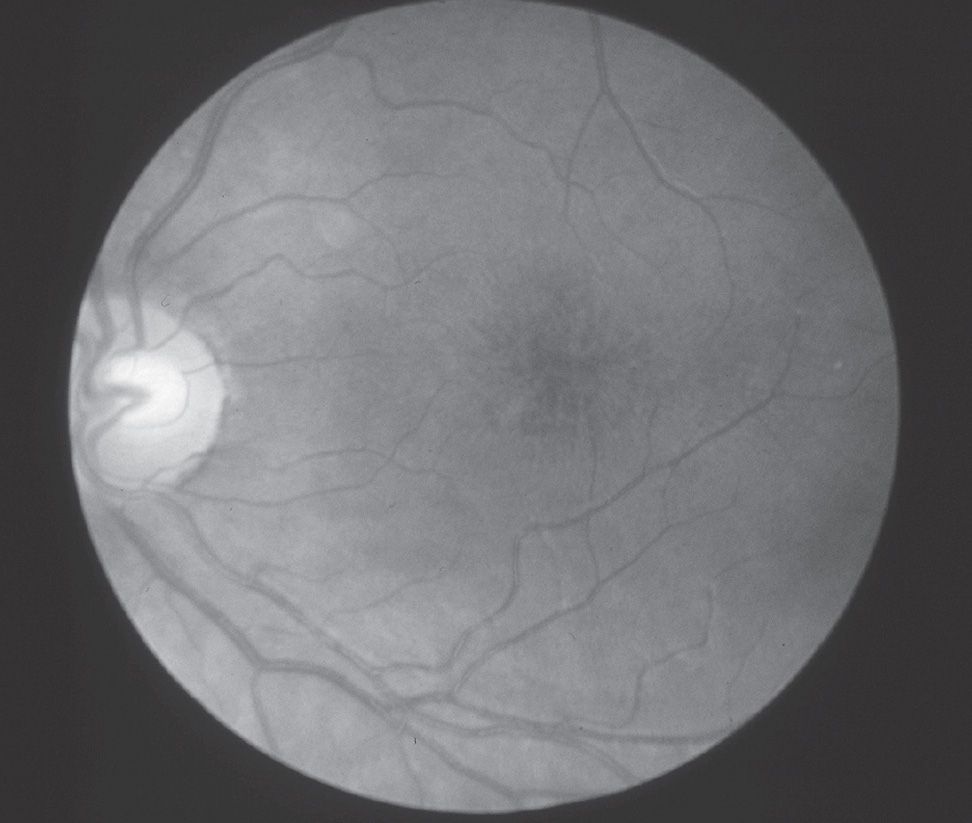
A) Spoke-wheel configuration of the macula
B) Cleavage of the retina at the nerve fiber layer
C) Attenuated b wave on electroretinogram (ERG)
D) Macular microcysts exhibit classic petalloid leakage on fluorescein angiography.
24 A 4-year-old girl presents for evaluation of poor vision. Ophthalmologic examination reveals translucent irides, hypopigmentation of the fundi, and foveal hypoplasia. Each one of the following may be an associated finding except:
A) bleeding diathesis
B) recurrent sinopulmonary infections
C) oculodigital massage
D) sensory nystagmus
25 Figure 5-14 is representative of a child infected with a nematode that was contracted from a common house pet. Which one of the following statements regarding this process is false?
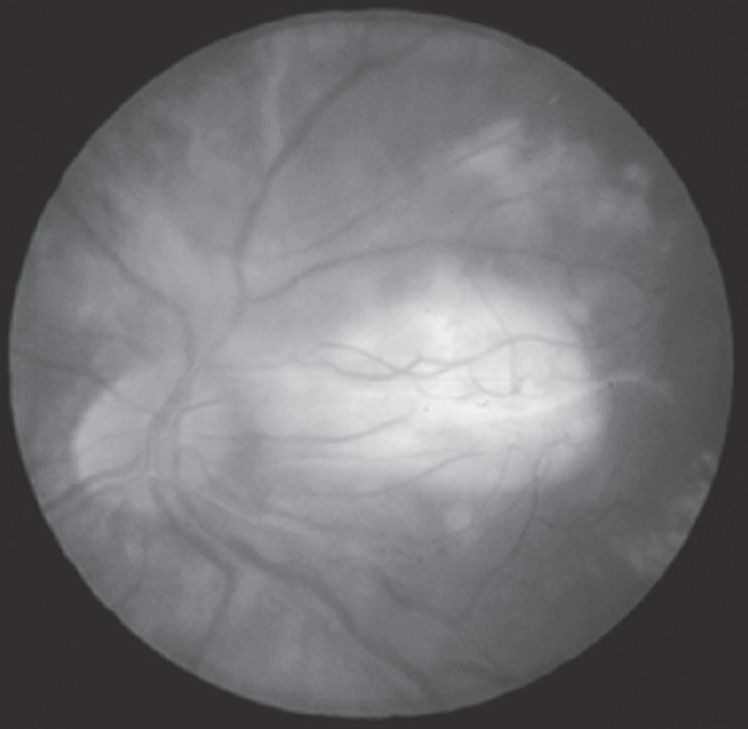
A) This infection may present with either anterior or posterior segment involvement.
B) The infection often manifests as an eosinophilic granuloma.
C) On CT, calcification is frequently present.
D) This infection can present as an apparent exotropia in which there are no refixation movements on alternate cover testing.
26 An infant is referred for poor tracking. On examination, the child does not fix or follow, there is searching nystagmus. The rest of the ocular exam is otherwise normal. Which one of the following is least likely in the differential?
A) Achromatopsia
B) Congenital stationary night blindness
C) Leber congenital amaurosis
D) Ocular albinism
27 Which one of the following statements regarding ocular toxoplasmosis is false?
A) Less than 10% of individuals younger than 5 years of age demonstrate antibodies against toxoplasmosis.
B) Toxoplasma oocysts shed by cats in their feces may remain infective for up to 1 year.
C) Maternal infection earlier in the course of pregnancy results in a greater risk of infection to the fetus.
D) Retinochoroiditis typically involves the retinal periphery and infrequently involves the macula.
28 According to the findings from the Early Treatment for Retinopathy of Prematurity Study (ET-ROP), laser therapy should be initiated for patients with which type of ROP?
A) Five contiguous clock hours of Zone II, Stage 3
B) Zone I, Stage 2
C) Zone I, Stage 3 with Plus disease
D) Zone III, Stage 1
29 An infant born prematurely at 27 weeks gestational age with a birth weight of 690 g demonstrates ROP as shown in Figure 5-15. The most appropriate next step would be:
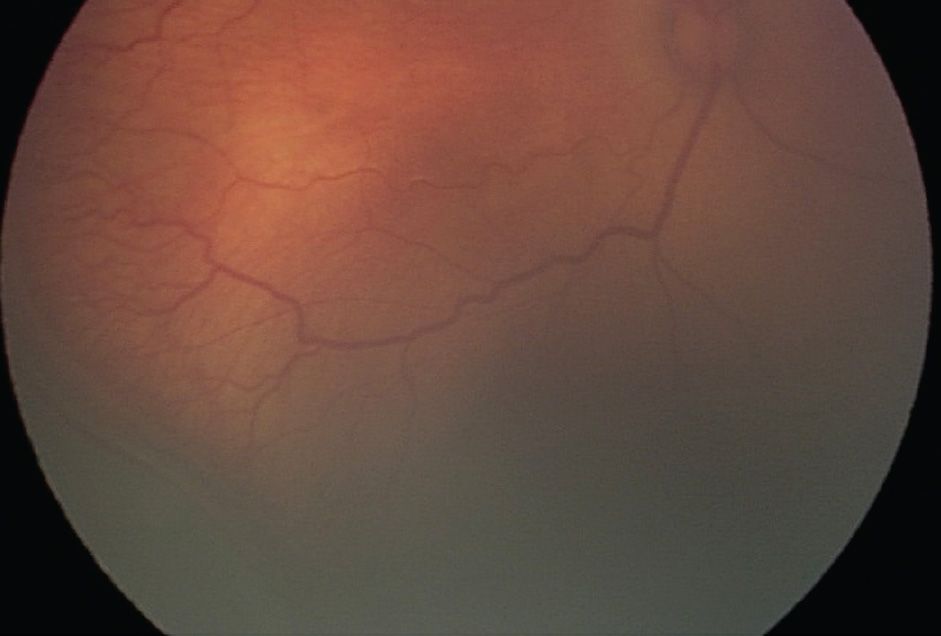
A) intravitreal bevacizumab within 72 hours
B) laser therapy within 72 hours
C) cryotherapy within 72 hours
D) close observation with repeat examination within 72 hours
30 Potential late complications of ROP include all of the following except:
A) strabismus
B) myopia
C) negative-angle-κ
D) glaucoma
QUESTIONS 31 and 32 A 11-month-old male presents with the examination findings shown in Figure 5-16 after an unwitnessed fall.
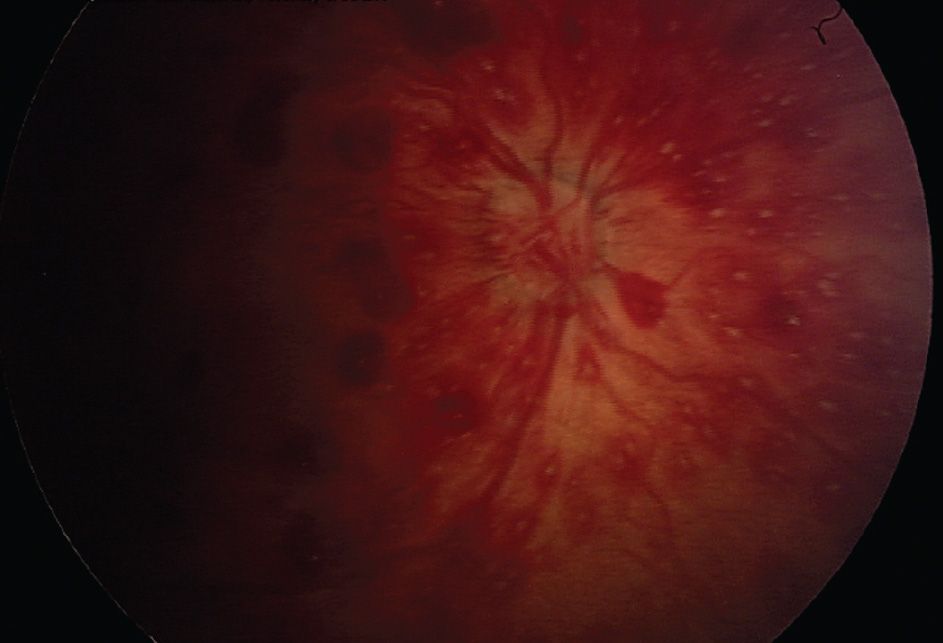
31 All of the following statements are true regarding this condition except:
A) Ocular findings are the presenting signs in 5% of child abuse cases.
B) Children affected are usually under 3 years of age.
C) Radiographic findings often include bilateral subdural hematomas.
D) Ocular findings typically resolve without long-term vision problems.
32 The next appropriate steps in management would include all of the following except:
A) contact child protective services to investigate for possible nonaccidental trauma
B) laboratory evaluation for coagulopathy
C) skeletal survey to evaluate for other signs of abuse
D) patching the contralateral eye for amblyopia management
33 Which one of the following statements regarding Coats disease is true?
A) It has an autosomal dominant pattern of inheritance with variable penetrance.
B) It is usually bilateral.
C) Males are affected more frequently than females.
D) It is usually diagnosed before 2 years of age.
34 A 5-year-old boy presents for evaluation of decreased vision. Ophthalmologic examination reveals degenerative changes involving the vitreous and retina and an optically empty vitreous. Which one of the following is the least likely diagnosis?
A) Wagner dystrophy
B) Stickler syndrome
C) Goldmann–Favre dystrophy
D) Kearns–Sayre syndrome
35 Which one of the following statements regarding retinitis pigmentosa is true?
A) The X-linked form is least common but most disabling.
B) Signs and symptoms typically precede ERG abnormalities.
C) Retinal pigmentary changes in the midperiphery are always present.
D) The initial visual field defect is a ring scotoma.
36 A 10-year-old girl is referred for an ophthalmologic examination after failing her school eye examination. Her best-corrected visual acuity is 20/50 in her right eye and 20/40 in her left. Examination reveals a normal anterior segment with an abnormal fundus appearance bilaterally. Her left eye is shown in Figure 5-17. Which one of the following would be most useful in establishing the diagnosis?
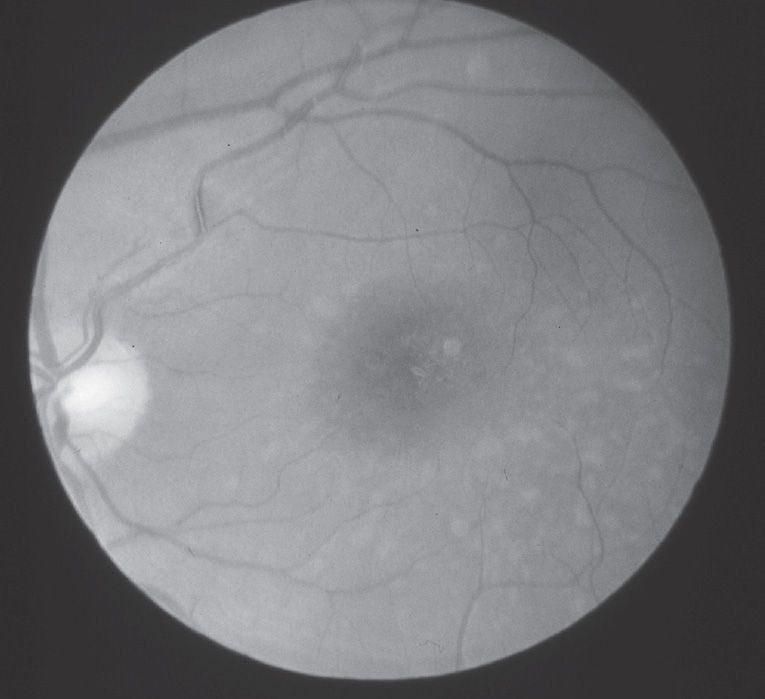
A) Electrooculogram (EOG)
B) ERG
C) Visually evoked cortical potential
D) Fluorescein angiogram
37 A 10-year-old boy is referred for evaluation of decreased vision in his left eye. Examination reveals an uncorrected visual acuity of 20/20 in his right eye and 20/40 in his left, which is correctable to 20/20 with glasses. Examination of the left fundus reveals a yellow-orange cystic macular lesion (Fig. 5-18). The father of this child reports that several members of his family including himself and a sister have suffered from mild to moderate deterioration of vision since youth. Which one of the following would be most helpful in establishing the diagnosis?
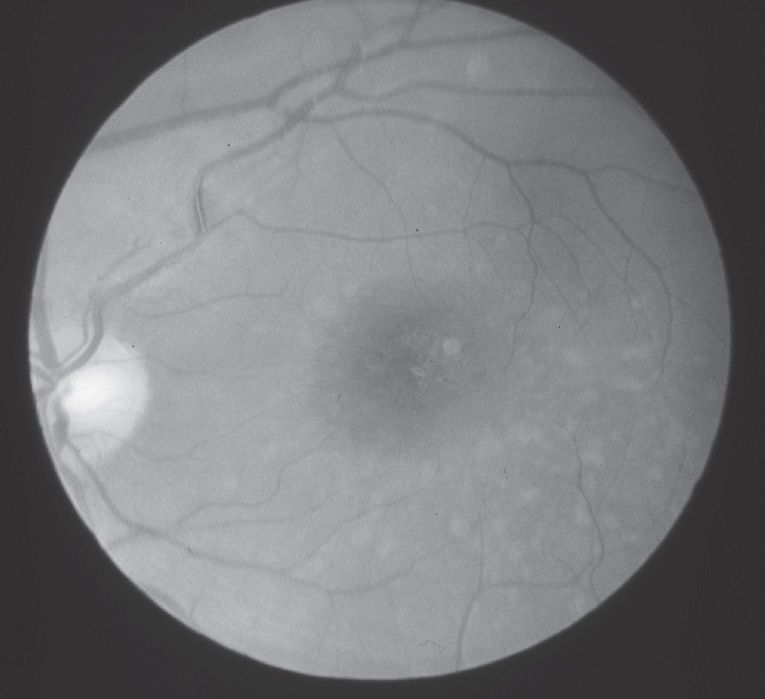
A) EOG
B) Ultrasound
C) Visual-evoked cortical potential
D) Fluorescein angiogram
QUESTIONS 38–42 Optic nerve disorders (Figs. 5-19 to 5-24).
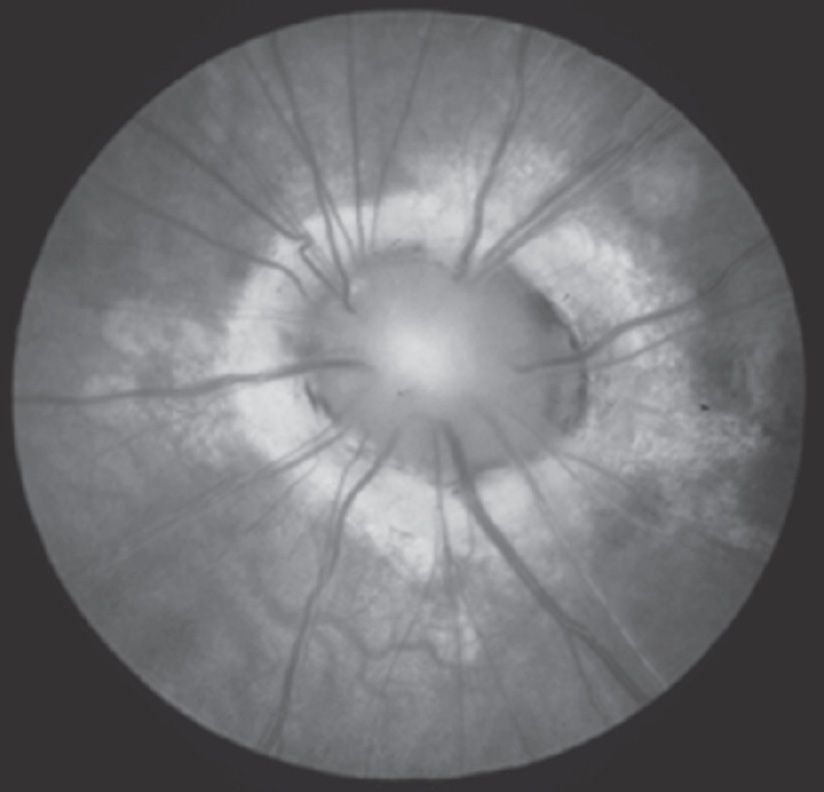

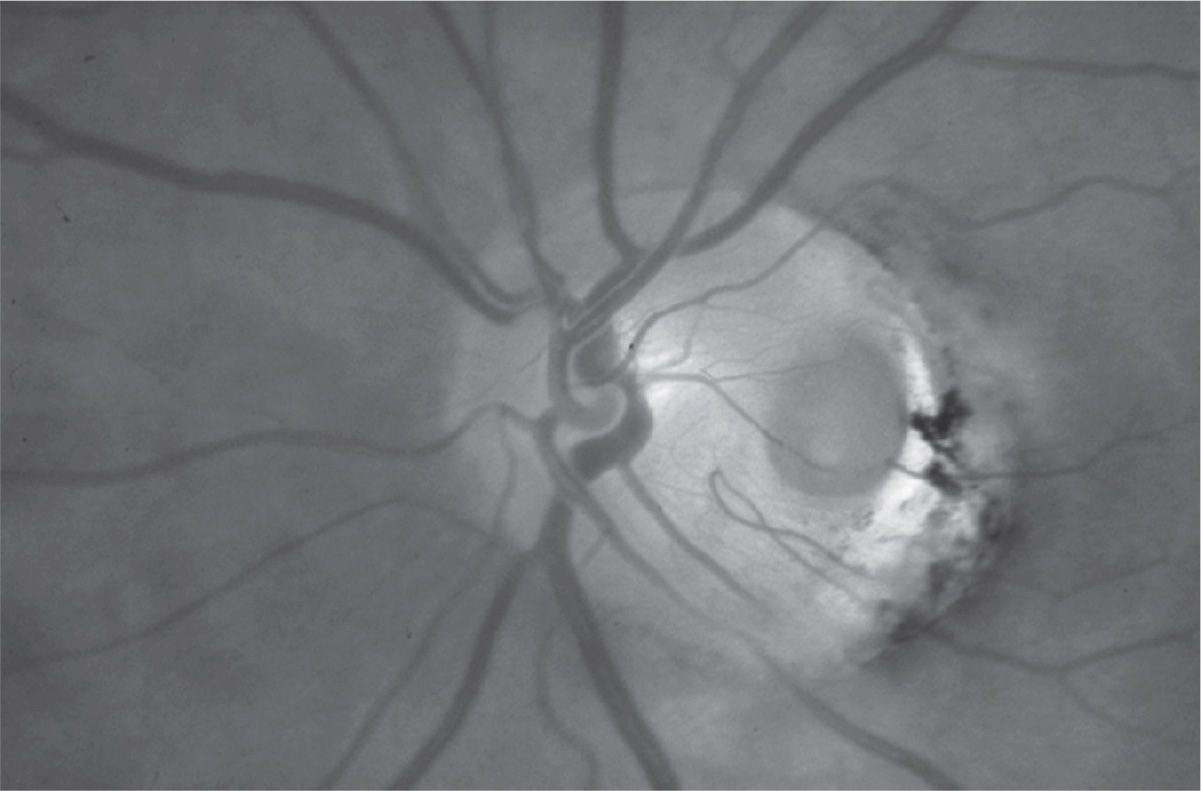
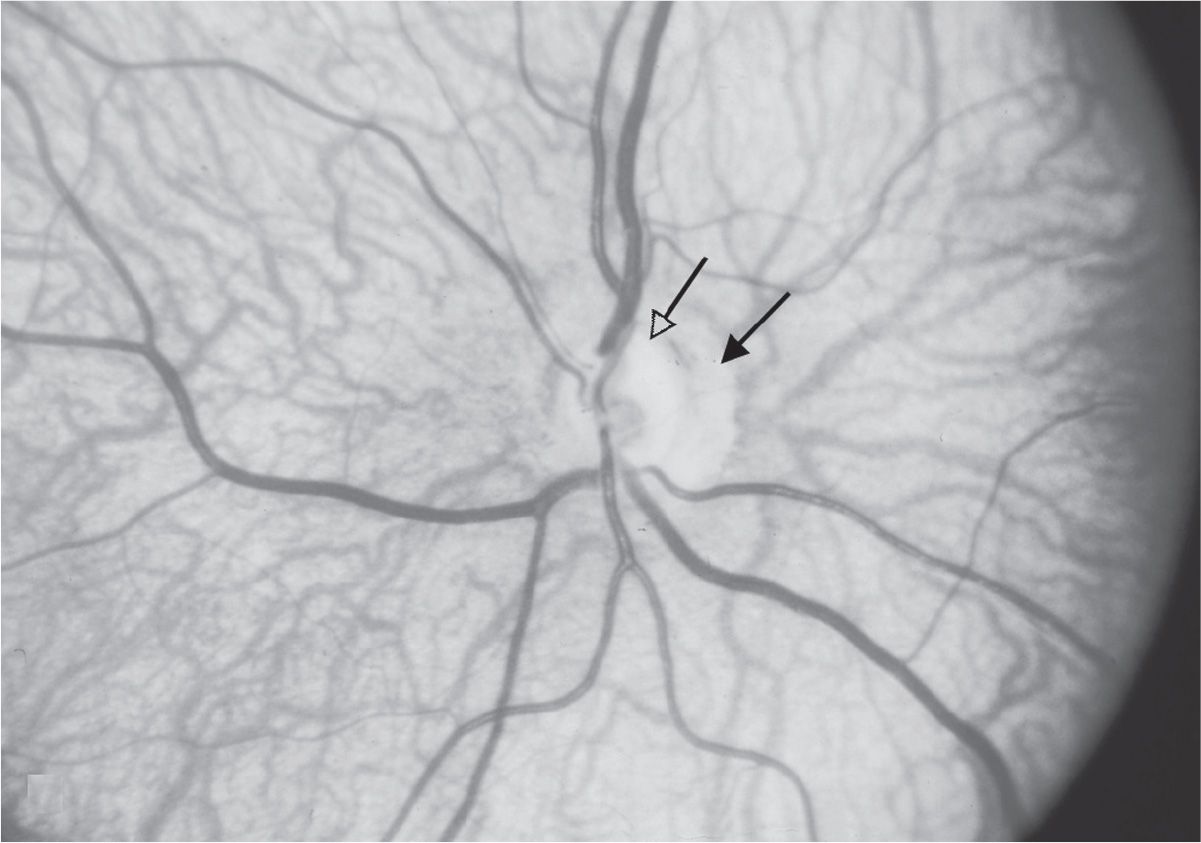
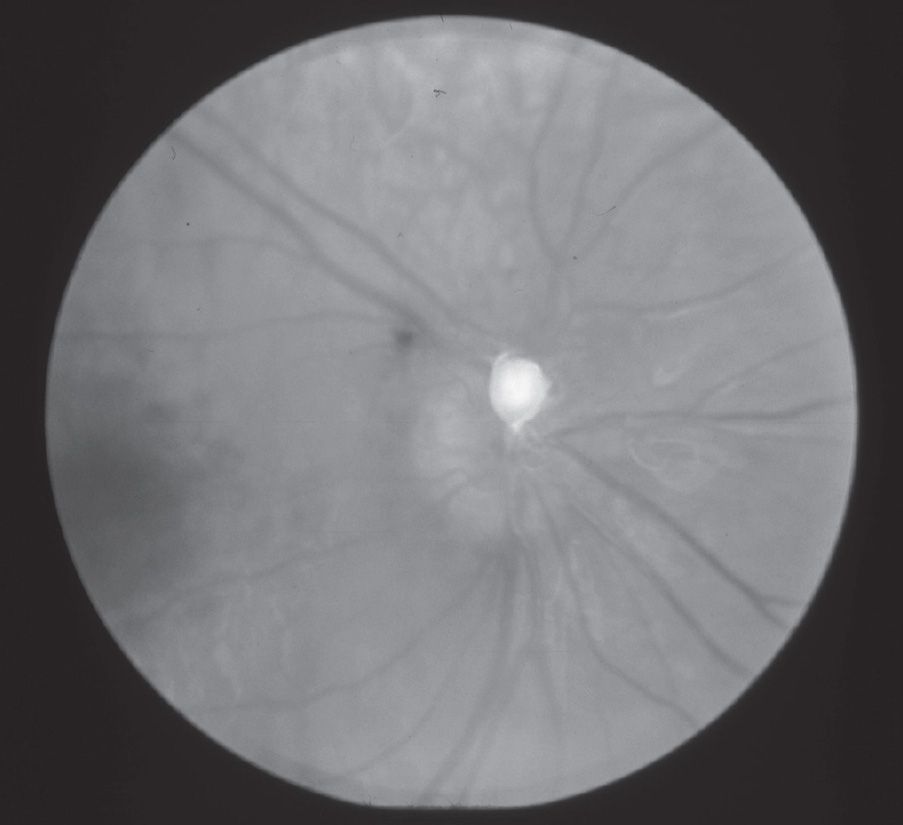
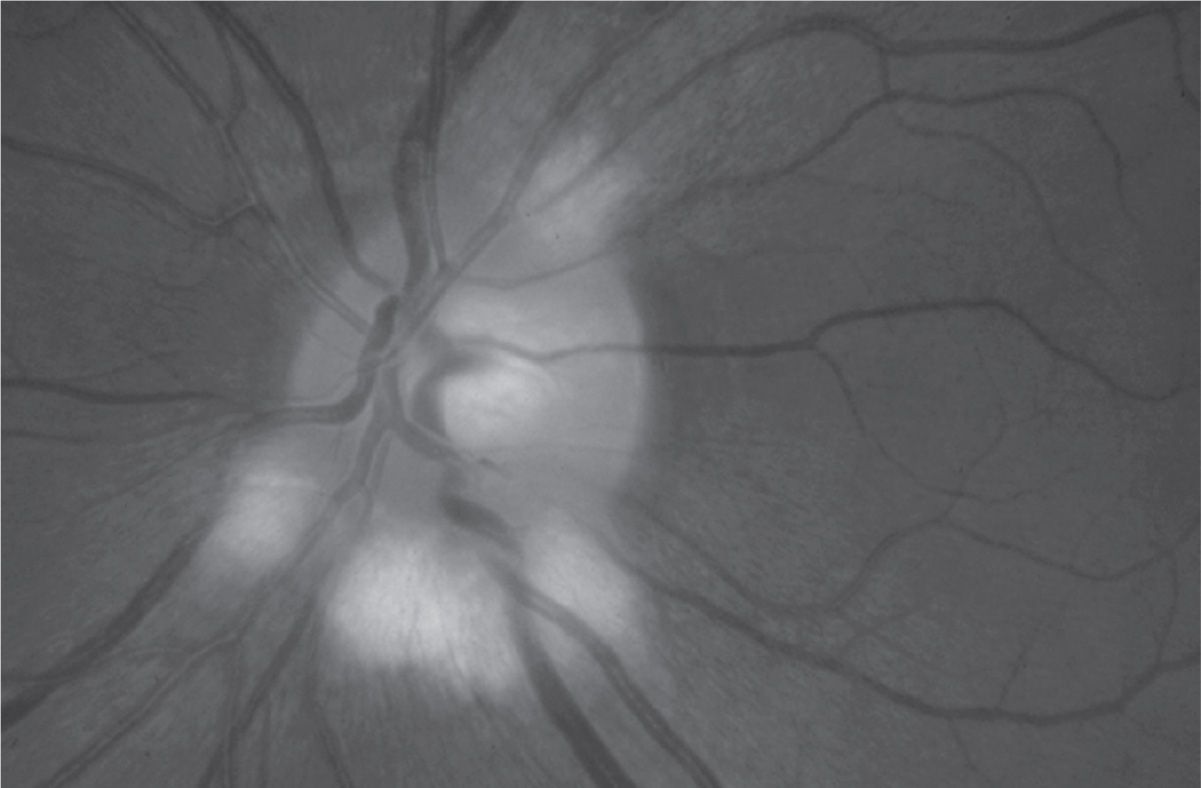
38 Which figure is associated with glial proliferation and folding of the retina?
A) Figure 5-19
B) Figure 5-20
C) Figure 5-22
D) Figure 5-23
39 Which figure is a result of faulty closure of the fetal fissure?
A) Figure 5-20
B) Figure 5-22
C) Figure 5-23
D) Figure 5-24
40 Which condition requires an endocrine evaluation and neuroimaging studies?
A) Figure 5-20
B) Figure 5-21
C) Figure 5-22
D) Figure 5-24
41 Which patient is at risk for developing serous macular detachments?
A) Figure 5-19
B) Figure 5-21
C) Figure 5-22
D) Figure 5-23
42 Which condition is found in conjunction with the posterior lens opacity shown in Figure 5-25?
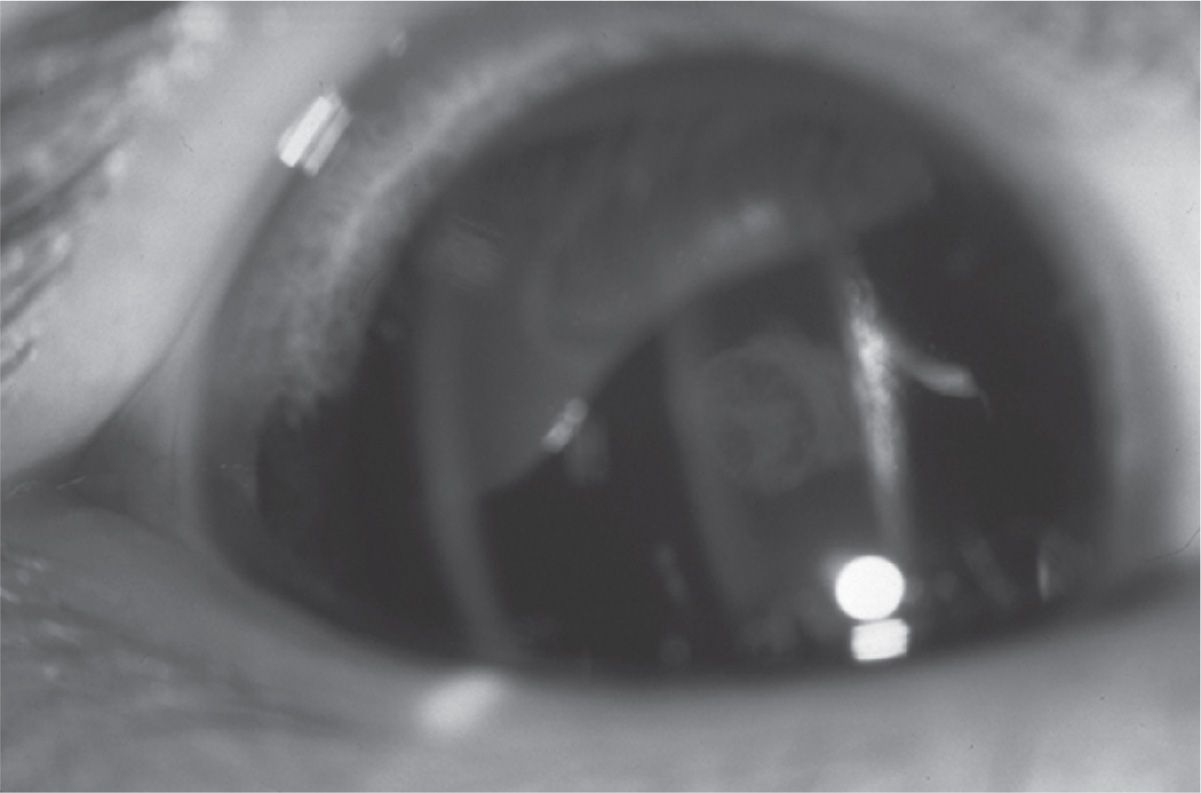
A) Figure 5-19
B) Figure 5-20
C) Figure 5-23
D) Figure 5-24
43 A 10-year-old asymptomatic male presents with the fundus finding seen in Figure 5-26. His vision, confrontational visual fields, color vision, pupils, motility, and anterior segment examination are within normal limits. What is the most appropriate next step in management?
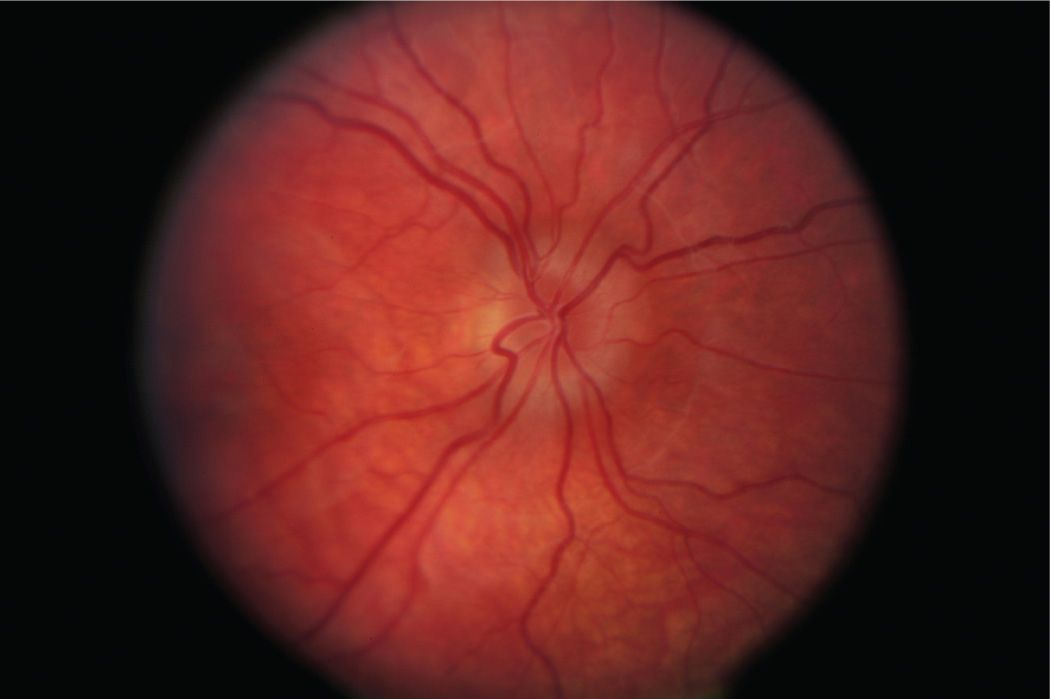
A) B-scan ultrasonography
B) Neuroimaging
C) Lumbar puncture
D) Ask if there is history of recent weight gain
44 All of the following are true regarding retinoblastoma (Rb), except:
A) Incidence is approximately 1 in 15,000 live births.
B) Presenting symptoms may include leukocoria, strabismus, cataract, and glaucoma.
C) Initial evaluation includes CT, lumbar puncture, and bone marrow biopsy.
D) Bilateral cases will typically present at <6 months and unilateral cases present at >12 months.
45 A 12-month-old male presents with the finding shown in Figure 5-27. All of the following statements are true regarding the inheritance of this condition, except:
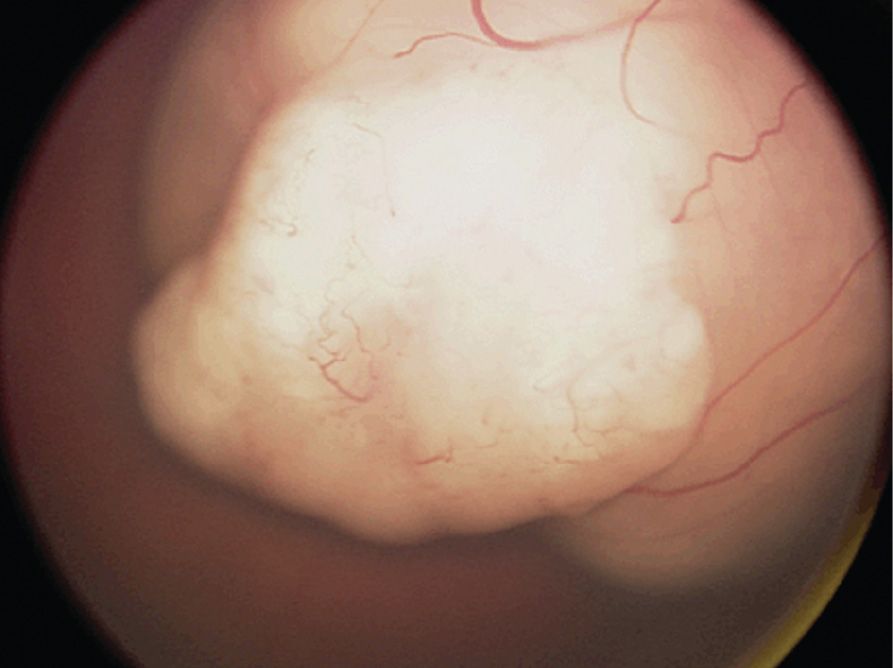
FIGURE 5-27 From Stocker JT, Dehner, LP, Husain AN. Stocker & Dehner’s Pediatric Pathology, 3rd ed. Philadelphia: Lippincott Williams & Wilkins, 2011.
A) 90% of newly diagnosed cases do not have a family history of this condition.
B) If the patient has a germline Rb1 mutation, there is a 50% chance the condition is bilateral.
C) If the patient has unilateral disease, he has a 15% chance of transmitting the condition to his offspring.
D) If the parent has a germline Rb1 mutation, there is an 85% chance the condition is bilateral.
46 The patient in Figure 5-28 has:
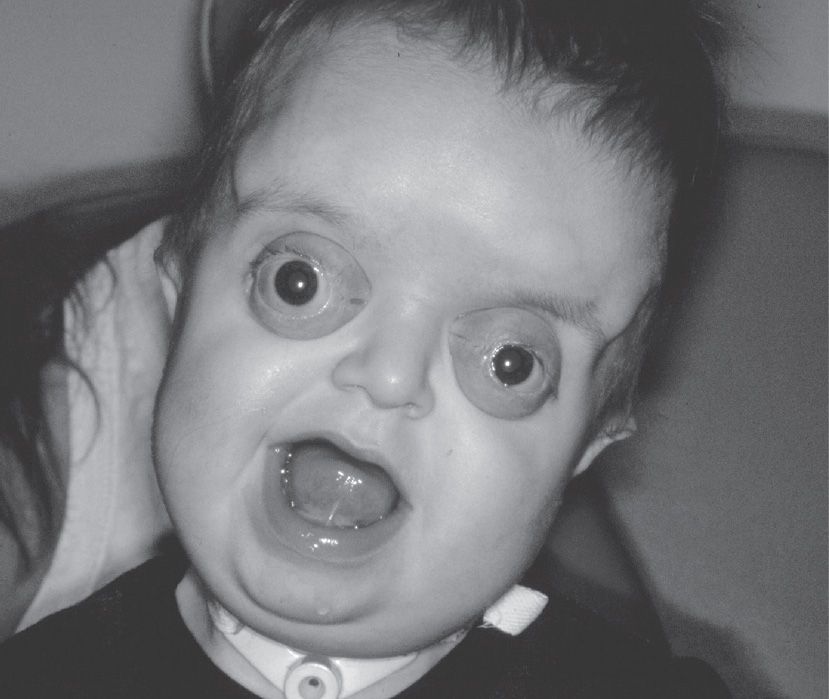
A) craniosynostosis—this patient would likely demonstrate midfacial hypoplasia, V-pattern exotropia, proptosis, and telecanthus.
B) Pierre Robin sequence—this patient would likely demonstrate micrognathia, glossoptosis, and cleft palate.
C) mandibulofacial dysostosis—this patient would likely demonstrate microstomia, coloboma, and malar and mandibular hypoplasia.
D) fetal alcohol syndrome—this patient would likely demonstrate an antimongoloid slant, deficiency of meibomian glands in the lower lid, and absent lower lid puncta.
47 A 9-month-old male presents with the finding seen in Figure 5-29. All of the following are true except:
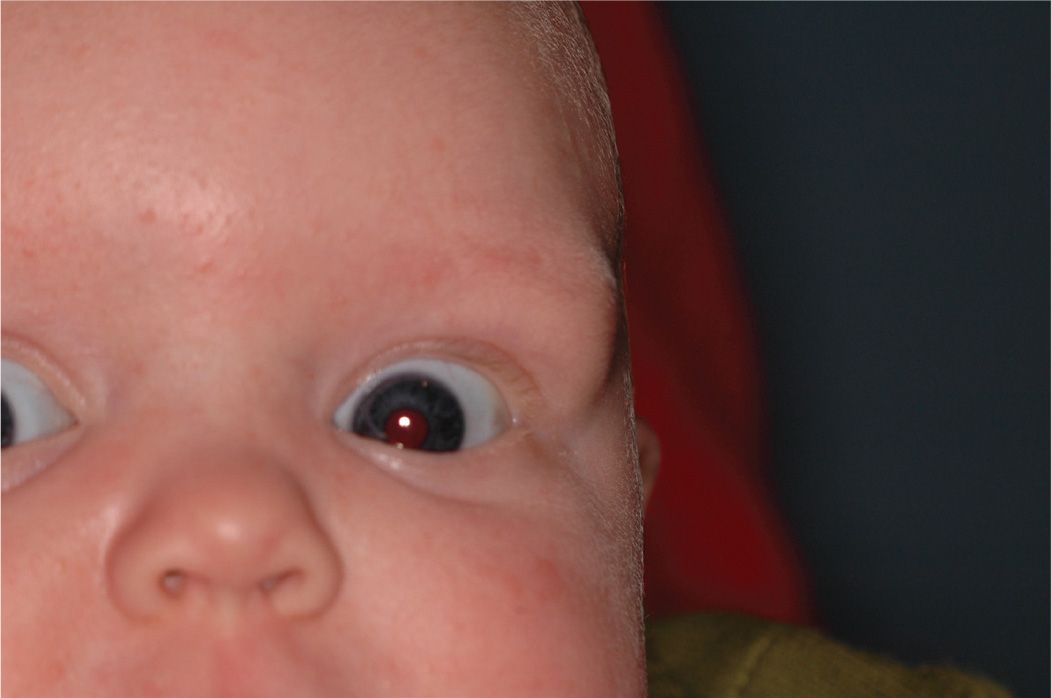
A) significant risk of amblyopia
B) most commonly seen in the superotemporal quadrant
C) may contain hair follicles, sweat glands, and sebaceous glands
D) differential diagnosis includes rhabdomyosarcoma and orbital cellulitis
48 An infant presents with a hyphema with no history of trauma. Which one of the following is the least likely cause?
A) JXG
B) Herpes simplex uveitis
C) Lymphoma
D) Rb
49 A 2-year-old boy presents with periorbital ecchymosis. The differential diagnosis includes all of the following except:
A) neuroblastoma
B) leukemia
C) lymphangioma
D) dermoid cyst
50 Neuroblastoma is characterized by all of the following except:
A) metastasis from the adrenal gland
B) possible spontaneous regression
C) poor prognosis if diagnosed before 1 year of age
D) periorbital ecchymosis
51 A 15-year-old male presents with the finding shown in Figure 5-30. Additional exam findings would include:

A) hyperpigmented macules
B) adenoma sebacuem
C) port-wine stain
D) conjunctiva telangiectasia
52 Which one of the following statements regarding neurofibromatosis is false?
A) Café-au-lait spots appear in over 99% of patients with this disorder.
B) Tumors of the CNS, including optic nerve gliomas, astrocytomas, acoustic neuromas, meningiomas, and neurofibromas, occur in 5% to 10% of patients with neurofibromatosis.
C) Lisch nodules appear in over 90% of patients over the age of 6 years but are nondiagnostic because they may appear in normal patients as well.
D) Up to 50% of patients with plexiform neurofibromas involving the upper eyelid develop ipsilateral glaucoma.
QUESTIONS 53 and 54 A 2-month-old female presents with the lesion shown in Figure 5-31.
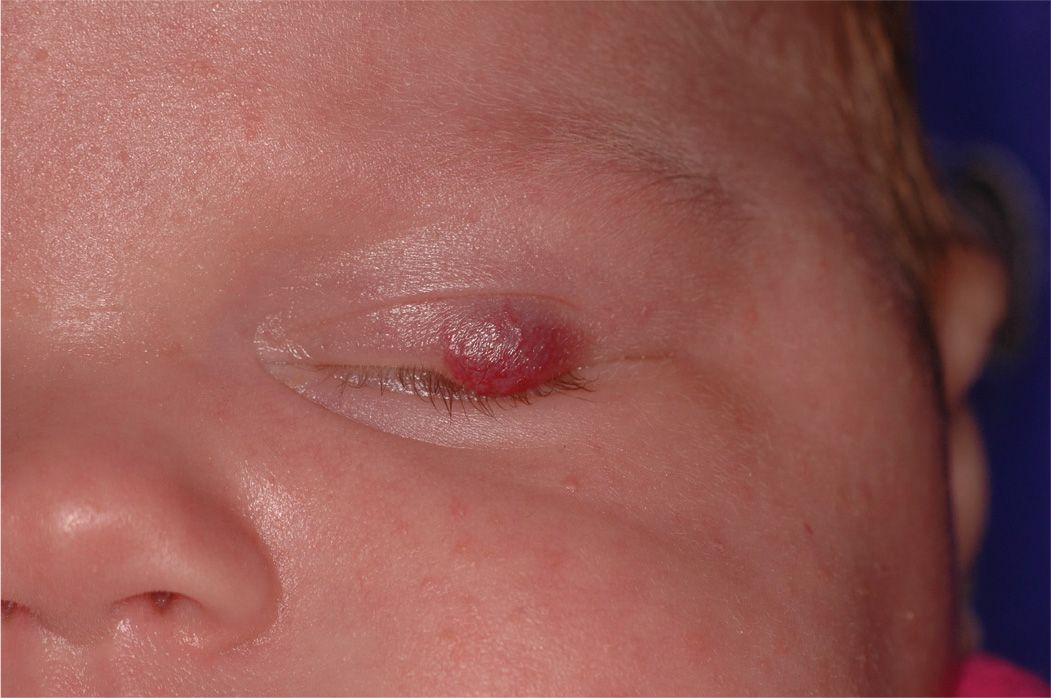
53 Characteristics of this lesion include all of the following, except:
A) clinically evident at birth
B) rapid proliferation and growth during first year of life
C) risk of anisometropic amblyopia
D) association with posterior fossa malformations
54 On examination, the patient has no fixation preference. Refractive error is +3.00 OU. Which treatment option is most appropriate for this patient?
A) Topical or systemic β-blocker
B) Corticosteroids
C) Refractive correction
D) Observation
55 The correct order of normal fusional amplitudes is:
A) convergence > divergence > vertical
B) convergence > divergence = vertical
C) vertical > divergence > convergence
D) convergence = divergence > vertical
56 All of the following can be used for to test for anomalous retinal correspondence (ARC) except:
A) red-glass test
B) afterimage test
Stay updated, free articles. Join our Telegram channel

Full access? Get Clinical Tree


